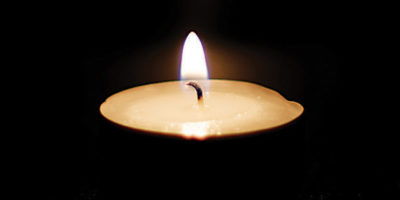What is your title and what do you do in the Blue Angels? Sure. My name is Nate Barton. My rank is lieutenant commander, and I am Blue Angel number 3. I fly left wing [in the diamond formation] for the team.
Okay, cool, so I heard that you joined the team about two years ago? I joined in 2012.
So how do you get to be a Blue Angel? Well, there’s a lot of sort of checks that you have to meet in order to apply. You have to have a requisite amount of experience flying in the Navy—in the Naval Marine Corps—prior to joining the team. So all the pilots have between 12 and 20 years of experience, I’d say, flying. Myself, I’ve got about 12 years experience flying, which is what most of the guys have. Then from that point, you know, there is a lot of career timing and stuff that goes into it. You know, all of us on the team are—we’re all career-oriented naval officers. So we, the team, we in no way want the team to interfere with our careers in the Navy. You know, this is a very brief tribute for all of us, so all of us here on the team, we are looking forward to going back to the, what we call “the fleet,” which is where we’ll fly gray airplanes off of gray aircraft carriers, and go through what the real Navy does.
So, combat missions? Right, exactly, exactly. And you know that’s something that all 130 members of the team take a lot of pride in. We say, ‘We came from the fleet and we’re going back to the fleet.’ Which means that we came from flying gray airplanes off of gray ships and you know, deploying in harm’s way, in support of our country’s mission. And so, that’s what we are all going to go back to.
So then what is the appeal of the Blue Angels that draws people away from that sort of career track for a period of time? What is it about the Blue Angels that makes people want to sort of take a little sabbatical with them? Sure, absolutely. I’ve actually never been asked that question before. Uh, it’s actually, uh, you know, like I said, we’re all very proud of what we did before we joined the team, what we’re going to do after we leave the team. I think, a lot of the appeal, or a lot of the allure to the team, is very obvious. You know, the team, in comparison with the rest of the Navy, is very high profile, and we get to do a lot of really cool things that in the Navy you would normally not have the opportunity to do. I think most of the guys on the team, including myself—guys and girls—would say that you know, that’s not why we came to join the team. You know, all of us really, really are drawn to the Blue Angels mission, and that’s to showcase the Navy and the Marine Corps, you know, showcase the pride and professionalism of the United States Naval Marine Corps. And we do that through inspiring a culture of excellence and service to country. That’s something that all of us really enjoy doing. We take pride in, our country, in our Navy, the marines, and the guys who are out there doing it right now while we are living this rather cushy life compared to them. So, it’s nice staying in hotels and getting to travel around the country—it’s great—absolutely, I would never argue with that. But you know, all of us really enjoy being able to represent those guys and do it to the best of our abilities and to showcase the excellence that they’re displaying on the ground in Afghanistan, or on ships in the Persian Gulf, or wherever they’re deployed.
What can people expect from the Blue Angels shows (Sept. 13 and 14) during Star-Spangled Spectacular? First off, you’re going to see a lot of high impact flying done by our C-130, which is affectionately known as Fat Albert. It’s a marine corps C-130 that was built to be a sort of a cargo plane and do a lot of different things, but it wasn’t built to fly air shows, which is what you’ll see it do in Baltimore. And the C-130, you know, there’s narration that goes with it, there’s music that goes with it, and they’ll explain, you know, what the C-130 does. It’s a really neat show.
So it’ll do, like, tricks? Absolutely. It’ll do maneuvers, you know, there in the Inner Harbor. It’ll precede the jet demonstration, the six F-18s, which is what the team is mostly known for. And that’s, you know, Blue Angels one through six, and you’ll see The Diamond, which is Blue Angels one through four, and that’s where I am. We’ll fly around in a diamond formation and showcase a lot of the precision formation flying that the naval marine corps does, and our solos will demonstrate more of the high-impact flying that the F-18 can do, as far as air speed and G’s and stuff like that. This show is a remote show, so it’s obviously over the water and then we’ll land [elsewhere]. You won’t see, you know, all of the behind the scenes stuff, and you won’t see what we do on the ground, and you won’t see our maintainers, you know, there at six in the morning turning the jets, getting them ready to go. You won’t see our, you know, our crew chiefs shaking our hands and telling us the jets are good to go. And you know, we just jump in as pilots and hit the start button and take off, that’s pretty much it.
Well sure, I’m sure there’s a lot that goes into it before it gets to a performance. The analogy can be made to actors: Before they even hit the stage there’s just a lot of people helping them get ready. So yeah, I would think it’s somewhat similar. Yeah, but we don’t have makeup artists. We do our own makeup!
Okay, I’ll give you that one. So, okay, what can these F-18s do? Like what is the height of their powers in terms of G’s and speed? Well, all of the F-18s that we fly, we get them from, these are older F-18s, so we get them from what we call “the fleet.” I hate to say that because that’s not a popular term. But we get them from the regular Navy, or what people view as the regular Navy. Our F-18s are actually older. They’ve been in combat, they’ve been in Iraq, they’ve been in Afghanistan, these jets. And they’ve just been painted to these shiny blue and yellow colors and kind of converted into air show birds. But these are the actual F-18s that the Navy flies off aircraft carriers into harm’s way. So you’ll see them fly, you’ll see a lot of the hot, high-speed stuff, you’ll see speeds in excess of 600 miles an hour. You’ll see the jets pulling G’s in excess of seven and a half G’s, which is what we’ll all pull on a daily basis. And you’ll also see some of the slower flying, the solos, the two solo pilots, five and six, will demonstrate some of the slow-speed flying characteristics as well, which is, for a lot of pilots, that’s sometimes more awe-inspiring than some of the fast stuff.
Well right, you need speed to create lift, right, isn’t that generally how airplanes work? Exactly. Yeah, exactly.
So, I would think going slowly would be tricky. So for you, when you are doing like seven and a half G’s or whatever, what does that feel like for you? And what do you have to do physically to prepare yourself to be able to sustain that? Well, it is certainly a physical challenge to pull seven and a half G’s, for instance. So, it takes a lot of physical conditioning, that we all train toward everyday. All the pilots, and I would say most of the team in general, all 130 of us, will typically workout six days a week. The pilots are mandated to workout six days a week, to make sure that we keep our core muscles in our body muscles ready to be able to flex them when needed. The reason we do that is, when you pull G’s, the blood wants to drain out of your head into your lower extremities. So obviously your brain is in your head, so you don’t want the blood to drain out of your head. That’s what causes problems. So, to combat that, we’ll basically tense up everything from our feet to our calves and our thighs, and our hamstrings, our glutes and our abs, and basically try to squeeze really tight to try and force that blood back up into our heads, or to not allow it to drain out. So it is very physically challenging, I’ll tell you, the first time I ever flew in the back seat of a Blue Angel jet I passed out, that was in the backseat, and luckily I’ve never passed out in the front seat. Knock on wood. That would be bad. Typically in flying the F-18s off aircraft carriers we would wear what we call a G-suit, and that’s basically a pair of pants, essentially, inflatable pants really, to dumb it down. It goes over your flight suit. It connects to the jet, and as you pull G’s, this inflatable G-suit inflates and basically squeezes your legs for you. So it kind of helps out a little bit with the G’s, and we don’t have that, we don’t wear those when we fly.
Right, so you have to kind of do it manually. Sure, exactly.
Okay, so, have there ever been any dicey moments? Well, you know, safety is our huge concern. You’re going to see the show and you’re going to think that we are going to hit a bunch of different times, it’s just, that’s just sort of how the show is supposed to go, you’re supposed to think that as a viewer. Everything that we do is completely legal, it’s been practiced thousands of times, literally, and it’s approved by the FAA. That being said, you know, what we do, we definitely take the safety of what we do very, very, very seriously. You know, safety is our number one concern in everything, and we would never do anything to take on an extra safety risk that we don’t have to, or to decrease that safety buffer that we have. So yeah, I mean, have we ever had close calls? Yeah, absolutely. You know there have been times when we’ve tensed up, you know, or you don’t fly the way you want to and sometimes those mistakes can be, you know, they can be potentially very costly. We obviously try to stay away from those by practicing over and over and over again and always aiming for perfection in everything that we do.
Well, so, what does your family think about you flying in these air shows? Are they at all worried for you, or just proud and excited? Well, you know I, I think, I would say that they’re mostly proud of me because I, we’re all the kind of guys who like to, who like to do very physical things. We liked to play sports in school. I’d say all 140 members of the team played sports at one time or another. There are a lot of college athletes on the team. Everyone’s kind of been in a very active lifestyle. So this is something that we are all used to. You know, my family knows that, you know, I’ve been in this for 12 years and I’ve been in harm’s way and so have the other guys. I think we’re all kind of just used to, like I said, we certainly don’t take it for granted the safety risks, but uh, you know, we don’t . . .
It just comes with the position. Right, right.
Well, so is it true that your family is from Pennsylvania? They are, yeah, they sure are. I’m from Hummelstown, Pennsylvania, which is, it is actually pretty close to Baltimore. So Baltimore is about as close to home as I can get this year, for an air show, which is exciting for us. You know, I’ll have a lot of family and friends from that area, from the Hershey, Harrisburg, area that come down to see us fly…
Well that’s awesome! That’ll be fun! Oh yeah, we’re stoked about it. It’s going to be great. We’re really looking forward to it. I mean, Baltimore is a really special place. I came there a lot growing up in Pennsylvania, it’s such an easy drive down there, and you know, spending time in the Inner Harbor and eating good food down there, you know, we love it down there.
Are you, by any chance, an Orioles fan? Umm, I can be for this show (laughs).
Good answer! I’ve been to a handful of Orioles games. I love to see them play. I haven’t been there in a while but, um, I haven’t been to many baseball games in a while just because our time restrains are pretty strict right now.
Right. Well so, will you get an opportunity to enjoy the festivities or will you just be sort of preparing for them? We do get a little bit of time at night once the day is over to be able to, you know, check out Baltimore and hang out and really experience, you know, that part of the country. We also though, we try to maximize our time in the area doing what we do, so you know, we’ll be busy with doing speaking engagements and this and that to really try to maximize what we’ve been given. And we certainly don’t take that for granted at all. So you know it’s great, it’s really fun, but it’s also really busy. So hopefully yeah we’ll have some time to check out the town, for sure.
So how many shows are you going to be doing over the course of the weekend? The first time that we’ll fly there is on Thursday. So we’ll fly two flights on Thursday, two practice flights, and then we’ll fly a practice on Friday. And the practice on Friday is really a full-up air show for us, it’s just a practice run through. And then on Saturday and Sunday are going to be the full-up shows. So, yeah, those are the days that we will actually be flying. So Saturday and Sunday are going to be the actual shows, although Friday is pretty much a show as well.




























